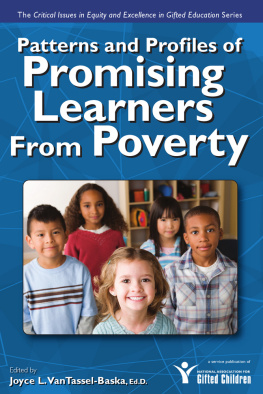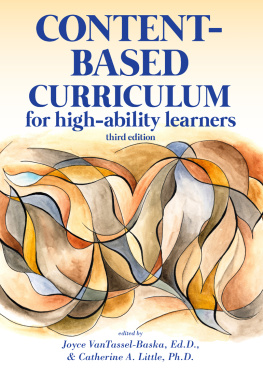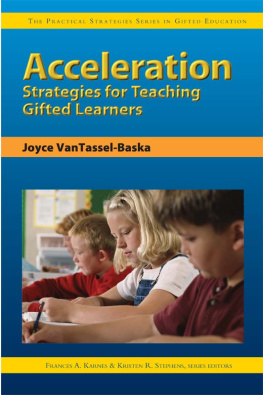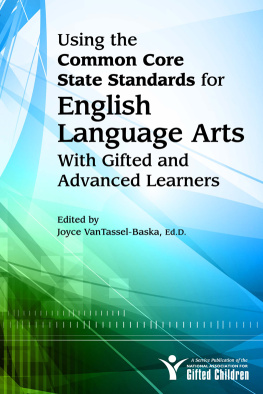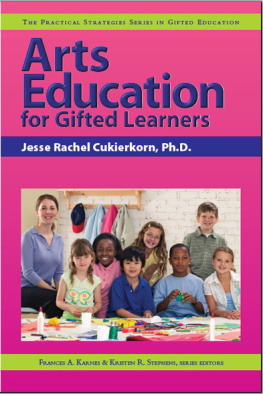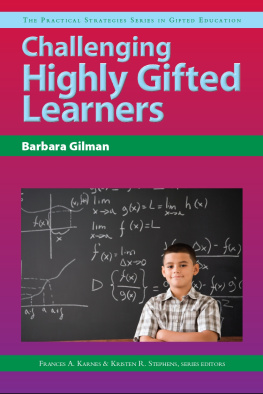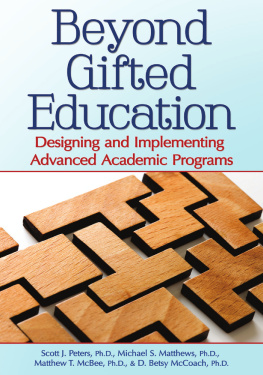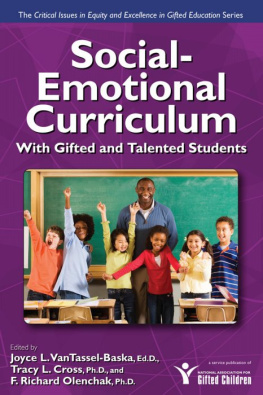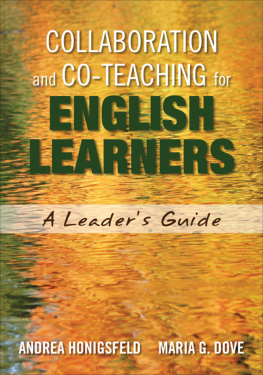Joyce VanTassel-Baska - Patterns And Profiles Of Promising Learners From Poverty
Here you can read online Joyce VanTassel-Baska - Patterns And Profiles Of Promising Learners From Poverty full text of the book (entire story) in english for free. Download pdf and epub, get meaning, cover and reviews about this ebook. year: 2009, publisher: Sourcebooks, genre: Home and family. Description of the work, (preface) as well as reviews are available. Best literature library LitArk.com created for fans of good reading and offers a wide selection of genres:
Romance novel
Science fiction
Adventure
Detective
Science
History
Home and family
Prose
Art
Politics
Computer
Non-fiction
Religion
Business
Children
Humor
Choose a favorite category and find really read worthwhile books. Enjoy immersion in the world of imagination, feel the emotions of the characters or learn something new for yourself, make an fascinating discovery.
- Book:Patterns And Profiles Of Promising Learners From Poverty
- Author:
- Publisher:Sourcebooks
- Genre:
- Year:2009
- Rating:5 / 5
- Favourites:Add to favourites
- Your mark:
- 100
- 1
- 2
- 3
- 4
- 5
Patterns And Profiles Of Promising Learners From Poverty: summary, description and annotation
We offer to read an annotation, description, summary or preface (depends on what the author of the book "Patterns And Profiles Of Promising Learners From Poverty" wrote himself). If you haven't found the necessary information about the book — write in the comments, we will try to find it.
Patterns and Profiles of Promising Learners From Poverty provides a comprehensive review of the issues surrounding the education and inclusion of promising students from poverty in gifted and talented programs.
Patterns And Profiles Of Promising Learners From Poverty — read online for free the complete book (whole text) full work
Below is the text of the book, divided by pages. System saving the place of the last page read, allows you to conveniently read the book "Patterns And Profiles Of Promising Learners From Poverty" online for free, without having to search again every time where you left off. Put a bookmark, and you can go to the page where you finished reading at any time.
Font size:
Interval:
Bookmark:



Copyright 2010, National Association for Gifted Children
Edited by Lacy Compton
Cover and Layout Design by Marjorie Parker
ISBN-13: 978-1-61821-324-2
No part of this book may be reproduced, translated, stored in a retrieval system, or transmitted, in any form or by any means, electronic, mechanical, photocopying, microfilming, recording, or otherwise, without written permission from the publisher.
At the time of this book's publication, all facts and figures cited are the most current available. All telephone numbers, addresses, and website URLs are accurate and active. All publications, organizations, websites, and other resources exist as described in the book, and all have been verified. The authors and Prufrock Press Inc. make no warranty or guarantee concerning the information and materials given out by organizations or content found at websites, and we are not responsible for any changes that occur after this book's publication. If you find an error, please contact Prufrock Press Inc.
| Prufrock Press Inc. P.O. Box 8813 Waco, TX 76714-8813 Phone: (800) 998-2208 Fax: (800) 240-0333 http://www.prufrock.com |
Contents
6. The Patterns and Profiles of Gifted African American Children: Lessons Learned
List of Tables
List of Figures
CHAPTER
Introduction: An Overview of Patterns and Profiles of Promising Learners From Poverty
Joyce VanTassel-Baska
Patterns and Profiles of Promising Learners From Poverty represents a labor of love. It is the last volume in the series on equity and excellence that I have edited during the past 4 years. It also represents one of our most critical issues as a field. How do we ensure that children of poverty have the opportunity to participate in gifted programs? How do we prepare them to be ready for such program participation? Can equity and excellence become twin realities in American education?
This book posits that poverty is the overarching variable that leads to underrepresentation in gifted programs, not race or ethnicity, nor gender. It is a culture all its own, with rules and mores for conduct by its members, at least among the working poor. It causes untold grief among its brightest members who have the desire, but not the means, to break its bonds. It stunts growth at critical periods of development and renders children vulnerable to lives of underachievement in school and life. Even as early as the 1940s, as we saw the results of the Terman study C group, we knew the power of low incomes in depressing achievement and happiness in all aspects of life (Terman & Oden, 1940).
Poverty is a family circumstance that affects more than 24 million children per year (Gross & Capuzzi, 2000; Hodgkinson, 2002). It knows no racial boundaries, as more Caucasian children are poor than all minority groups combined, even though more than half of all African American and Hispanic American families also reside in poverty. It knows no geographic boundaries either, as rural poverty is as extensive as that in urban areas, just less concentrated. It knows no gender bias, as both adult men and women experience poverty every day, many in homeless conditions. Single parent mothers, however, as a subgroup of women, are far more likely to experience poverty. Being poor also is a status, despite the American dream, that all but perhaps 5% of Americans are likely to remain in due to the insidious relationship of educational attainment and job accessibility. Sennett and Cobb (1972) confirmed the difficulty in moving up from the lower class in our society, suggesting that social mores, ones neighborhood, parental education and career, and the prevalence of divorce and child-bearing all collude to make upward mobility unlikely. Intergenerational poverty is common as well, particularly among African Americans, where the single parent rate constitutes more than half of the population.
Students from impoverished backgrounds are at greater risk for a host of social-emotional problems, including lower levels of motivation, when compared to children who do not come from such backgrounds (Beirne-Smith, Patton, & Ittenbach, 1994). Oftentimes, the risks for social-emotional problems come from related special challenges for students living in poverty, including higher rates of disabilities, teenage mothers, absent fathers, lower motivational levels, parents without resources, health problems, concerns about safety and daily survival, and increased risk of homelessness (Beirne-Smith et al., 1994; Stormont, 2000).
The chapters in this book represent a vision of poverty that is based in an understanding of the cultural and social identity issues of the minority poor as well as the particular aspects of the poor from urban and rural areas, and aspects of the perceptions that poor children, their parents, and their teachers hold about the value of gifted programs in the context of their learning preferences and habits. A chapter on curriculum delineates prototypical models that can address characterological needs. There also are chapters that address the support networks necessary to assure that these children are accepted and nurtured within the gifted program context through professional development and local and state policies that facilitate rather than impede their progress.
The Kitano chapter, , focuses on the impact of culture and its role in shaping children of poverty. It lays out the cultural pattern found among several minority groups and suggests that students from these cultures manifest their competence in different ways, many times alien to classroom norms and patterns for traditional achievement. Using Rogoffs (2003) sociocultural perspective, she posits that the instructional context for culturally diverse learners matters as much as their individual characteristics in being successful. Kitano suggests that teachers need to provide a supportive environment for culturally diverse learners, including acknowledging their cultural strengths and sharing them with others as well as working on the transference of culturally based competence to school-based expectations for competence. She highlights differences between home and school cultures of these learners to emphasize the gap that teachers must bridge while maintaining high expectations for performance. She ends the chapter with a set of questions for teachers on how they are addressing cultural diversity in their classrooms.
, the Worrell chapter, lays out the research on social identity, especially among African Americans. He posits that two theories are central in understanding the construct of social identity: sense of belonging and stereotype threat. These theories allow us to understand the individual need to connect to groups and how group perception of ones own culture can negatively impact upward mobility, especially in respect to advanced educational access and attainment. His central thesis is that African American students disproportionately experience psychosocial stressors that interfere with academic achievement due to several factors that include oppositional defiant behaviors born of being involuntary minorities in America, misconceptions of ability as innate, and fear of letting down ones race. Worrell advocates for providing stronger social support networks in university-based gifted programs and providing counseling that is targeted on these identity issues in order to keep potentially gifted learners from nonmainstream cultures on a positive educational path.
Next pageFont size:
Interval:
Bookmark:
Similar books «Patterns And Profiles Of Promising Learners From Poverty»
Look at similar books to Patterns And Profiles Of Promising Learners From Poverty. We have selected literature similar in name and meaning in the hope of providing readers with more options to find new, interesting, not yet read works.
Discussion, reviews of the book Patterns And Profiles Of Promising Learners From Poverty and just readers' own opinions. Leave your comments, write what you think about the work, its meaning or the main characters. Specify what exactly you liked and what you didn't like, and why you think so.

